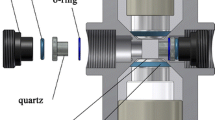Abstract
A dynamic transition at temperatures ∼200–230K is observed in manyhydrated bio-polymers. It shows up as a sharp increase of the mean-squaredatomic displacements above this temperature range. We present neutronscattering data of DNA at different levels of hydration. The analysis showsthat the dynamic transition in DNA is related to a slow relaxation processin the MHz-GHz frequency range. This slow relaxation process iscompletely suppressed in the dry DNA sample where no dynamic transitionwas observed. The nature of the slow process is discussed. We ascribe it toa global relaxation of DNA molecule that involves cooperative motion ofmany base-pairs and backbone.
Similar content being viewed by others
References
Nienhaus, G.U., Mourant, J.R. and Frauenfelder, H.: Spectroscopic Evidence for Conformational Relaxation in Myoglobin, Proc. Natl. Acad. Sci. USA 89 (1992), 2902–2906. Post, F., Doster, W., Karvounis G. and Settles, M.: Structural Relaxation and Nonexponetial Kinetics of CO-Binding to Horse Myoglobin, Biophys. J. 64 (1993), 1833–1842.
Parak, F., et al.: Evidence for a Correlation Between the Photoinduced Electron-Transfer and Dynamic Properties of the ChromophoreMembranes from Rhodospirillum-Rubrum FEBS Lett. 117 (1980), 368–372.
Rasmussen, B.F., Stock, A.M., Ringe, D. and Petsko, G.A.: Crystalline Ribonuclease-A Loses function Below the Dynamic Transition at 220-K, Nature 357 (1992), 423–424.
Ferrand, M., Dianoux, A.J., Petry, W. and Zaccai, G.: Thermal Motions and Functions of Bacteriorhodopsin in Purple Membranes-Effects of Temperature and Hydration Studied by Neutron Scattering, Proc. Natl. Ac. Sci. USA 90 (1993), 9668–9672.
Doster, W., Cusak, S. and Petry,W.: Dynamical Transition of Myoglobin Revealed by Inelastic Neutron Scattering, Nature 337 (1989), 754–756.
Tsai, A.M., Neumann, D.A. and Bell, L.N.: Molecular Dynamics of Solid-State Lysozyme as Affected by Glycerol and Water: A Neutron Scattering Study, Biophys. J. 79 (2000), 2728–2732.
Cordone, L., Ferrand, M., Vitrano, E. and Zaccai, G.: Harmonic Behavior of Ytrehalose-Coated Carbon-Monoxy-Myoglobin at High Temperature. Biophys. J. 76 (1999) 1043–1047.
Sokolov, A.P., Grimm, H., Kisliuk, A. and Dianoux, A.J.: Slow Relaxation Process in DNA at Different Levels of Hydration, J. Biol. Phys. S1-S5 (2000).
Rupprecht, A.: Preparation of Oriented DNA by Wet Spinning, Acta Chem. Scand. 20 (1966) 494–504.
Grimm, H. and Rupprecht, A.: Statics and Dynamics of oriented DNA as seen by Neutrons, Physica B 174 (1991) 291–299.
Grimm, H. and Rupprecht, A.: Low Frequency Dynamics of DNA, Physica B 234-236 (1997), 183–187.
Lindsay, S.M., Lee, S.A., Weidlich, T., Demarco, C., Lewen, G.D. and Tao, N.J.: The Origin of the A to B Transition in DNA Fibers and Films, Biopolymers 27 (1988) 1015–1043.
Transport Theory and Statistical Physics, Special Issue Devoted to Relaxation Kinetics in Supercooled Liquids-Mode Coupling Theory and Its Experimental Tests, Eds. Nelson, P. and Allen, G.D.,24 (1995) 755–1268.
Bennemann, C., Baschnagel, J. and Paul, W.: Molecular-Dynamics Simulation of a Glassy Polymer Melt: Incoherent Scattering Function, Eur.Physical J. B 10 (1999) 323–334.
Rössler, E., Sokolov, A.P., Kisliuk, A. and Quitmann, D.: Low-Frequency Raman Scattering on Different Types of Glass Formers used to Test Predictions of Mode-Coupling Theory, Phys. Rev. B 49 (1994) 14967–14978.
Franosch, T., et al.: The Evolution of Structural Relaxation Spectra of Glycerol within the Giga Hertz Band, Phys. Rev. E 55 (1997) 3183–3190.
Bergman, R., et al.: Dynamics around the Liquid-Glass Transition in Poly(propylene-glycol) Investigated by Wide-Frequency-Range Light-Scattering Techniques, Phys. Rev. B 56 (1997) 11619–11628.
Kisliuk, A., Mathers, R.T. and Sokolov, A.P.: Crossover in Dynamics of Polymeric Liquids: Back to TII ? J. Pol. Sci. Phys. 38 (2000) 2785–2790.
Fitter, J., Lechner, R.E. and Dencher, N.A., Biophys. J. 73 (1997), 2126.
Sokolov, A.P., Grimm, H. and Kahn, R.: Glassy Dynamics in DNA: Ruled by Water of Hydration? J. Chem. Phys. 110 (1999), 7053–7057.
Mashimo, S., et al.: Dielectric Study on Dynamics and Structure ofWater Bound to DNA Using a Frequency Range 107-1010 Hz, J. Phys. Chem. 93 (1989), 4963–4967.
Hogan, M.E. and Jardetzky, O.: Internal Motions in Deoxynucleic Acid II, Biochemistry 19 (1980), 3460–3468.
Early, T.A. and Kearns, D.R. Proc. Natl. Acad. Sci. U.S.A. 76 (1979) 4170–4174.
Sokolov, A.P., Hurst, J. and Quitmann, D.: Dynamics of Supercooled Water: Mode-Coupling Theory Approach, Phys. Rev. B 51 (1995), 12865–12868.
Rights and permissions
About this article
Cite this article
Sokolov, A., Grimm, H., Kisliuk, A. et al. Slow Relaxation Process in DNA. Journal of Biological Physics 27, 313–327 (2001). https://doi.org/10.1023/A:1014228824104
Issue Date:
DOI: https://doi.org/10.1023/A:1014228824104




